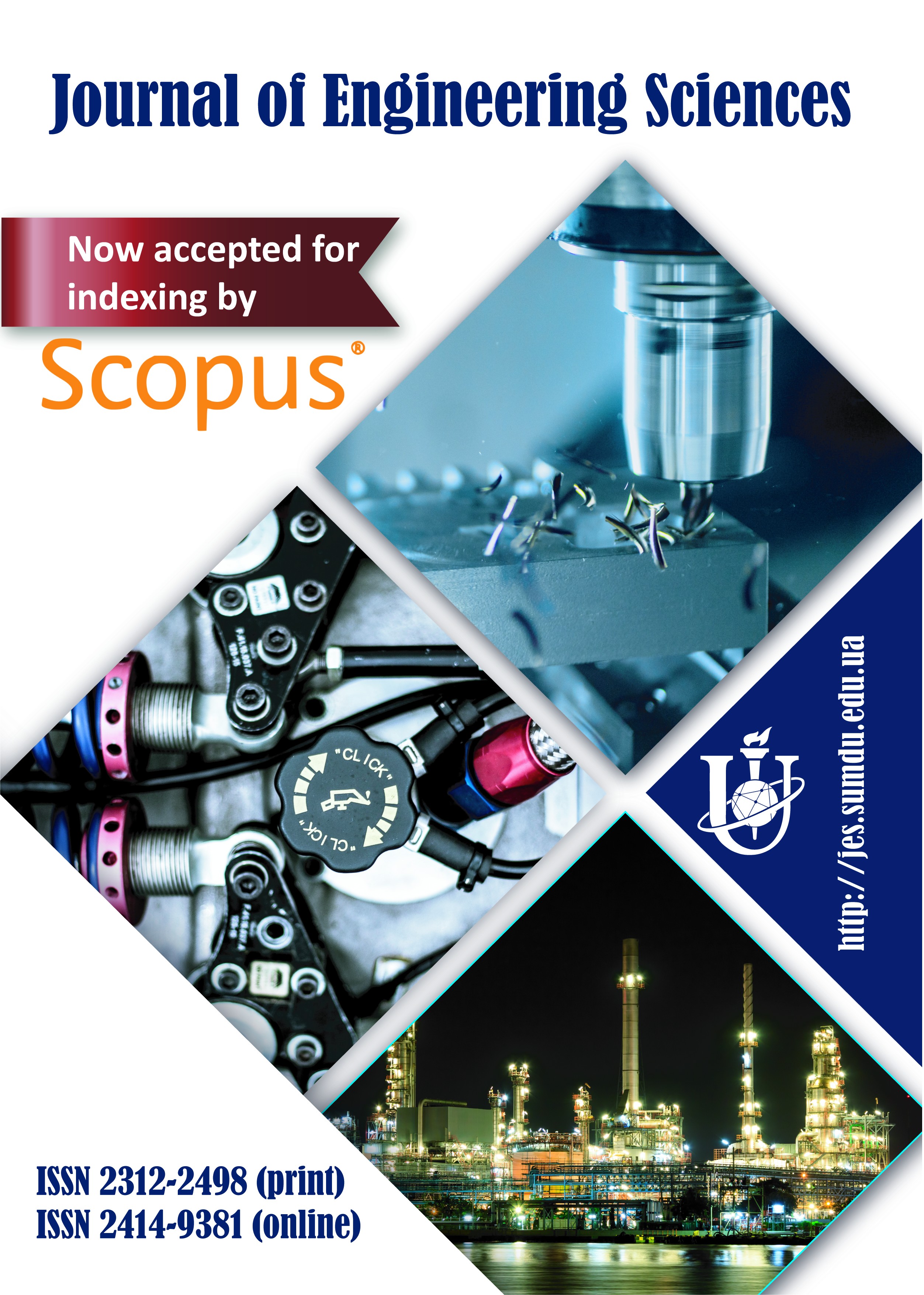Contact of Working Surfaces for Spherical Washers and Recommendations for Determining the Gap in the Joint
Author(s): Dehtiarov I. M.1*, Neshta A. O.1, Samardak M. P.2, Antosz K.3, Avramenko S. E.1
Affiliation(s):
1 Sumy State University, 2, Rymskogo-Korsakova St., 40007 Sumy, Ukraine;
2 PJSC “Nasosenergomash”, 1, Pryvokzalna Sq., 40011 Sumy, Ukraine;
3 Rzeszow University of Technology, 12, Powstańców Warszawy Al., 350959 Rzeszow, Poland
*Corresponding Author’s Address: [email protected]
Issue: Volume 7, Issue 2 (2020)
Dates:
Paper received: June 12, 2020
The final version of the paper received: December 8, 2020
Paper accepted online: December 14, 2020
Citation:
Dehtiarov I. M., Neshta A. O., Samardak M. P., Antosz K., Avramenko S. E. (2020). Contact of working surfaces for spherical washers and recommendations for determining the gap in the joint. Journal of Engineering Sciences, Vol. 7(2), pp. B1–B7, doi: 10.21272/jes.2020.7(2).b1
DOI: 10.21272/jes.2020.7(2).b1
Research Area: MANUFACTURING ENGINEERING: Technical Regulations and Metrological Support
Abstract. In article analyzes the technical requirements for spherical washers used in threaded connections of pumps, which made it possible to highlight contradictions in paragraphs of the current standards for pump fasteners. They regarding recommendations for manufacturing technology and control of the working surfaces of washers. Publication analysis in the spherical surfaces lapping showed the absence of research in the spherical surfaces contact after lapping and the dependence of contact parameters by the technological parameters for this operation. The presence of a gap in conjunction with spherical washers after the lapping process was proved geometrically. Its location was determined, and a mathematical dependence was obtained to determine the maximum gap value in conjunction. It was found that the gap depends on the design parameters of the washers’ conjunction and the abrasive material grain size used for lapping. Recommendations for selecting the abrasive material grain size for the lapping operation for the most common values of the roughness parameters for the working surfaces of spherical washers have been formed. In the article was proposed to introduce into the technical requirements for the spherical washers drawings changes concerning the gap size allowable in the conjunction, and as well as tolerances value changes of the radii of the working surfaces of the washers, thus increasing their manufacturability without conflicting with the requirements of the current standards.
Keywords: lapping, turning, tolerance, contact square, manufacturability.
References:
- Maji, K. I., Sulaiman, C., Abdul-Rahim, A. S. (2019). Renewable energy consumption and economic growth nexus: A fresh evidence from West Africa. Energy Reports, Vol. 5 pp. 384–392, doi.org/10.1016/j.egyr.2019.03.005
- Labaj, J., Husar S. (2015) Analysis of gear pump designed for manufacturing processes. Applied Mechanics and Materials, Vol. 803, pp. 163-172, doi.org/10.4028/www.scientific.net/AMM.803.163
- Poel, J. D., Waveren, C. C. (2012) Managing centrifugal pump reliability in the context of the total cost of ownership. South African Journal of Industrial Engineering, Vol. 18(2), pp. 57-70, doi.org/10.7166/18-2-119
- Hawash, S., El Gazzar, D El Samanoudy, M (2015). Reliability improvements to centrifugal pump performance in conjunction with inducers, CFD comparative study. Journal of Earth Science and Engineering Vol. 5, pp. 296-305, doi: 10.17265/2159-581X/2015.05.004
- Shao, J., Zhang, Y.Q. (2014). Research on operational reliability index of a centrifugal pump. Applied Mechanics and Materials Vol. 494-495, pp. 408-411, doi.org/10.4028/www.scientific.net/AMM.494-495.408
- Roeske, D., Adolf, K., Peschel, D. (2000) Lever optimization for torque standard machines. Proceedings of the 16th IMEKO World Conference, Wien, Austria, Data (e.g., September 25-28), 2000.
- Chuang, C. H., Tso, p. L.. (2006). An investigation of lapping characteristics for improving the form error of an aspheric lens. Journal of Materials Processing Technology, Vol. 176(1–3)pp. 183-190, doi.org/10.1016/j.jmatprotec.2006.03.134
- Fiocchi, A. A., Sanchez, L. E., et al. (2016). The ultra-precision Ud-lap grinding of flat advanced ceramics. Journal of Materials Processing Technology, Vol. 231, pp. 336-356, doi.org/10.1016/j.jmatprotec.2015.10.003
- Yuan, J., Yao, W., et al. (2015) Kinematics and trajectory of both-sides cylindrical lapping process in planetary motion type. International Journal of Machine Tools and Manufacture, Vol. 92, pp. 60-71, doi.org/10.1016/j.ijmachtools.2015.02.004
- Durakbasa, M. N., Osanna, P. H., Demircioglu, P. (2011). The factors affecting surface roughness measurements of the machined flat and spherical surface structures – The geometry and the precision of the surface. Measurement, Vol. 44(10), pp. 1986-1999, doi.org/10.1016/j.measurement.2011.08.020
- Chen, J., Sun, T., et al. (2021). A novel agglomerated diamond abrasive with excellent micro-cutting and self-sharpening capabilities in fixed abrasive lapping processes. Wear, Vol. 464–465, p. 203531, doi.org/10.1016/j.wear.2020.203531
- Huang, S., Li, X., et al. (2020). Machining characteristics and mechanism of GO/SiO2 nanoslurries in fixed abrasive lapping. Journal of Materials Processing Technology, Vol. 277, p. 116444, doi.org/10.1016/j.jmatprotec.2019.116444
- Yang, J., Wang, X., Kang, M. (2018). Finite element simulation of surface roughness in diamond turning of spherical surfaces. Journal of Manufacturing Processes, Vol. 31, pp. 768-775, doi.org/10.1016/j.jmapro.2018.01.006
- Dehtiarov, I., Neshta, A., Samardak, N. (2020). Problems of manufacturing of spherical shims forseparable connectors of pump equipment. Proceedings of the 21st International Conference “Progressive technology, technology, and engineering education”, Kyiv, Ukraine, Data (e.g., October 6-9), 2020.
- PNAE G-7-008-89. Rules for design and safe operation of equipment and pipelines of nuclear power plants. NTC YRRB of Gosatomnadzor, Moscow, Russia.
- GOST R 54786-2011. Fasteners for detachable conjunctions of nuclear power plants. Technical conditions. Standartinform, Moscow, Russia.
- Doi, T. K., Ohnishi, O., et al. (2015). Handbook of Ceramics Grinding and Polishing (Second Edition) Chapter 6 – Lapping and Polishing, Boulevard, Langford Lane, Kidlington, Oxford, USA, 263-325, doi.org/10.1016/B978-1-4557-7858-4.00006-6
- Khoshaim, A. B., Xu, Z., Marinescu, J. D. (2015). Handbook of Ceramics Grinding and Polishing (Second Edition) Chapter 9 – ELID Grinding with Lapping Kinematics, Boulevard, Langford Lane, Kidlington, Oxford, USA, pp. 394-448, doi.org/10.1016/B978-1-4557-7858-4.00011-X







